I'll go through an example here of Ancestry DNA results to show you how to understand them a little better. Also, if you haven't tested and you want to see what you might get if you do test, this might help nudge you off the fence.
DNA testing has been amazing experience for me, and I hope that this post can help you get a little more from your test results.
You did what you've been talking about doing for a few years: You spit in a tube and had your DNA analyzed.
You waited between 4-8 weeks, on average, and they sent you an e-mail with your DNA results. Or maybe you were lucky and got your e-mail only after waiting 2-3 weeks (it happens!).
... Now what?
(This is the first post of a TWO part series... you can read the second post here.)
How to Access the Different Sections of Ancestry Results
When you log into Ancestry, click on the "DNA" tab at the top of the screen. This will take you to a page that looks like the screenshot below.
Believe it or not, some people feel overwhelmed at all of the information even on this small section of the page any never explore further.
Don't be one of those people; there is still so much to learn about your results!
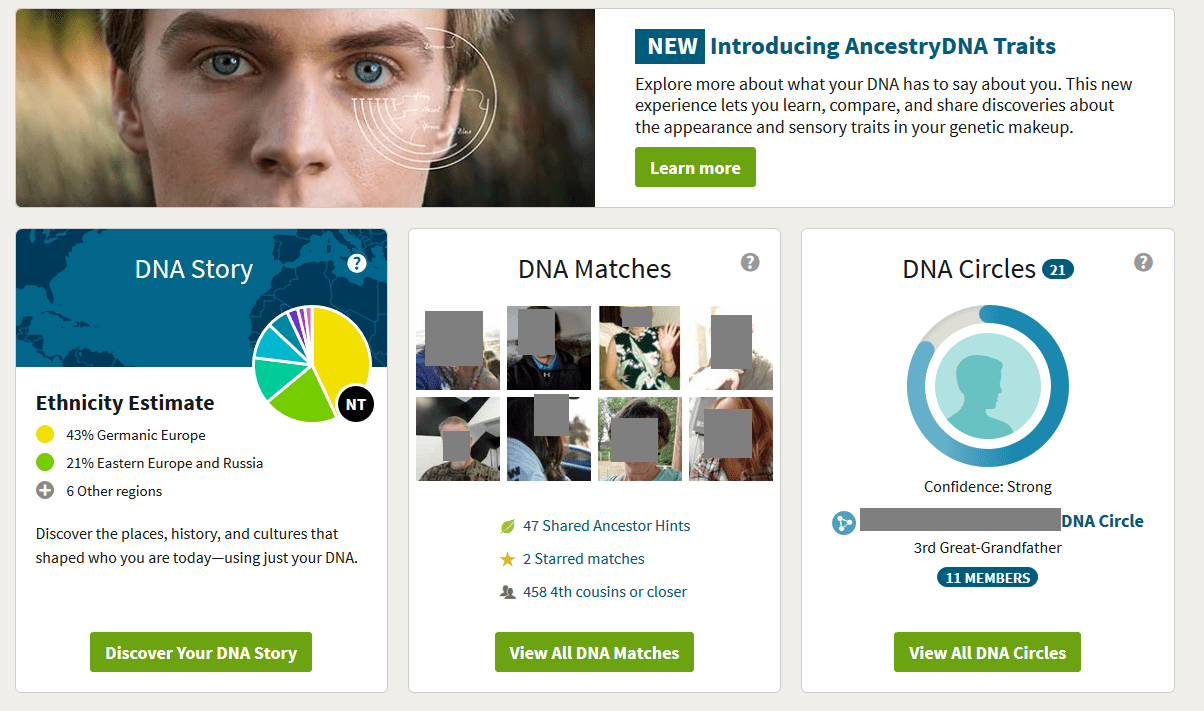
Scroll down a bit to get to the good stuff. Your test will give you ethnicity results and relative (we call them "cousin" matches) matches who have done the test, as well.
In addition, you can view "DNA Circles". I'll talk about each one in more detail later in this post.
Your DNA results are broken down into two main sections, plus a "bonus" section:
- Ethnicity Estimate
- DNA matches
- DNA Circles (bonus section)
Now, we will explore each of the three sections one-by-one.
Genetic Ancestry on Ancestry DNA
This is a relatively new aspect of DNA testing, but it is very exciting. Have you ever heard a story in your family about a Native American great-great grandmother?
Do you feel like a fraud on St. Patty's Day because you don't really know if you are Irish or not? Well, your DNA ethnicity results can do a lot to help you figure this all out.
How does Ancestry DNA calculate your ethnicity?
Every company or research organization that offers these estimates (because they are only estimates, even though they are fairly accurate) uses a reference population. They collect DNA samples from people all over the world who can verify that their families have lived in the same area for several generations.
Once they have collected sufficient samples from a particular region, they are able to develop a reference panel for that region. Then, they compare your DNA to all of the available reference panels.
If you click on "Discovery Your DNA Story", it will take you to a new screen where you'll see much more information, including a map of the world illustrating the regions contained within your DNA. You'll also see a more detailed breakdown of your ethnicity regions.
Yours will look something like mine, but of course the regions and percentages will be different:
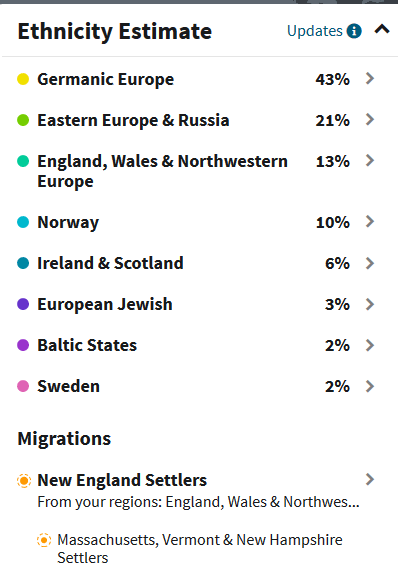
My father's family has Colonial US roots (British) on his mom's side, and Dutch/German/Polish ancestry on his dad's side. On my mom's side, I have Polish/Slovak/German and Colonial US (Irish/British) heritage.
I was surprised to see 10% Norway and 2% Sweden on my results, but not surprised to see 3% European Jewish.
Based on my Ancestry, it makes a lot of sense to see such high percentages Germanic Europe and Eastern Europe and Russia. If anything, based on my paternal grandmother's British ancestry, I had expected to inherit more than just 13% from her.
Your Ancestry DNA results can change!
The screenshot of my DNA results is not the same as it was when I first took my DNA test. In fact, it has changed several times! Ancestry DNA automatically updates your ethnicity results when they get new science or updated technology - even if you don't have a subscription.
You can always log in to see if there have been any changes. While there won't be any major adjustments, you might occasionally see a slight difference, which means that your estimate just got a little more accurate.
The most recent update was in September 2022, which corresponds with the general schedule of a major fall update.
Trace Regions in Ancestry DNA Results
Note: This section pertains to the old version of Ancestry DNA results before the major September 2018 update.
Even though I wasn't really surprised, I knew that there might be some secrets hidden in those results, and there might in yours, too. Click on the "Show 6 More Regions" link. Yours may have more or less regions, depending on your own results.
It's important to note that Ancestry DNA has removed the trace regions, or low confidence regions, in new results after September 2018. This means that many Ancestry DNA customers will not see low confidence regions in their updated results, either.
From a personal perspective, I have mixed feelings about the disappearance of the trace regions. I believe that we are provided with greater accuracy and will no longer need to speculate about potentially inaccurate parts of our results.
On the other hand, the speculation was fun and many people found truth in their low confidence regions that they may not have known about if they had initially been left off the results.
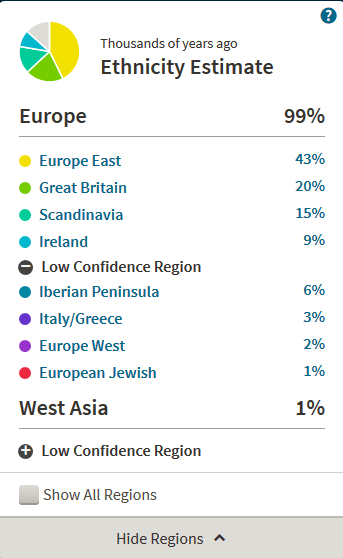
(Note: Click on the little plus sign next to Low Confidence Region in order to expand this section.)
These results were surprising for me. I didn't have any Irish ancestors that I was aware of. I actually had expected to find more European Jewish, since there was a rumor about my grandmother being Jewish (completely unsubstantiated, as many family rumors go).
I had also thought that I might find some Native American DNA, since one of my great-grandmother's had "looked" like she might be Native American, according to other family lore. Additionally, I knew that I had a ton of German ancestors, but where was all their DNA?
I had a lot to learn about all of this! And the things that I learned will be topics for other posts, since I just want this one to be a basic overview of how to view and understand the results. There really is a lot of nuance to this, however, so for those who are interested there will be more.
Does 0% really mean that you have none of a particular ethnicity region?
I am a very stubborn person by nature, and I don't like to take "no" for an answer. I really had been expecting some Native American to show up in my ethnicity report.
It turns out that if you click on the little box next to "Show All Regions", you can look at all of the regions that they test for and see the results.
There are several reasons why I was expecting to find Native American in my DNA results, which I will definitely talk about at another time.
If there is something that you are expecting to find, you can expand to all of the regions and scroll to look at that exact region. The results will give you a range. For example, according to Ancestry, my range for Native American is less than 1%:
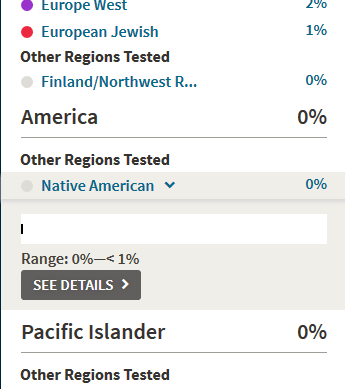
Believe it or not, I saw this is as a glimmer of hope that I had been right... maybe. And when I click on some of the others, like Polynesian, it gives me a range of ZERO percent. I was hopeful to see the range of "less than 1%".
We don't inherit ethnicity from all of our ancestors
One important aspect of ethnicity estimates that I feel compelled to mention is that our ethnicity estimates don't display results from all of our ancestors. This is because we didn't inherit DNA from all of our ancestors. Every child inherits only 50% of each parent's DNA, which also means that they don't inherit 50% of each parent's DNA.
The end result of this, from an ethnicity estimate perspective, is that some ethnicity information is not passed down each generation.
Our ethnicity estimates can help us learn which regions the DNA that we did inherit likely matches, but it can't tell us anything about the DNA that we didn't inherit.
It's possible to not have inherited very much DNA from great-great grandparents, and very possible to share almost no DNA with great-great-great-great grandparents. We will have inherited DNA from some of these ancestors, but not all of them.
To really understand your results, start building a family tree right away
This is one reason why I really encourage people who have done DNA testing to build their family trees using their DNA results as a general guide, and their DNA matches as a tool.
The best place to build your family tree - especially if you did your DNA test with Ancestry, but even if you didn't, is on the Ancestry site. It's free to build as many trees as you want and it's easy to share them with family.
Having access to all of Ancestry's records is a huge advantage, but you do need a subscription for access to records, documents, and photographs.
Conclusion
After I saw my ethnicity results, I knew that I wanted to set out to find out how I got all of these different ethnicities. For some, it was easy for me to find. I still have ancestors to find, and hopefully they will help me finish telling my story.
(Do you want to see my entire ethnicity estimate? Read this post: Example of Ancestry DNA results)
If you find anything interesting or unexpected in your DNA results? It's very common to find an unexpected trace ethnicity - or even a major ethnicity. Many people also find new family members when they check their family matches.

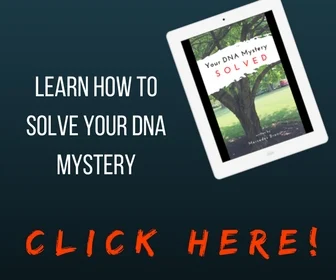
Helen Kruse
Friday 19th of January 2018
My Daughter recently sent to have our Heritage DNA done. I never knew my dad and it bothered me my whole life, although I didn't dwell on it. My eye colour is more amber,and even my Daughter wanted to know as it's her Grandfather. In this DNA test, I am like 43% Iberian so I assume that is from him. The rest is Baltic and Eastern Europe which I already knew. My Mom's side is totally Lithuanian. I'm 3rd generation from there. Then there is like 10%-20% of Irish,Scottish,English,Welsh. On the Heritage site so far it has found only family on my Mothers side. I had names to start with there,but on my Dad's side I don't have anything at all. How can I learn more or track possible other DNA matches on that side? My email address is [email protected] You can write me there. Thanks ~ Helen Kruse
Mercedes
Sunday 28th of January 2018
Hi Helen, Thanks so much for your comment - I will send you an e-mail with some ideas. I think it is great that your daughter is curious about her grandfather, and DNA testing is a great first step - so you are moving in the right direction.